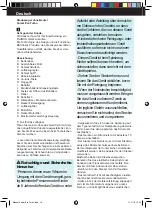
- Open the lid of the dust box and empty the
contents into the appropriate waste disposal
receptacle. (K)
- Close the lid of the dust box. (Fig. 5)
- Attach the dust box to the appliance. (Fig. 6)
- Connect the hose to the vacuum cleaner’s air
intake. (Fig 1)
Changing the filters:
- Motor filter, it is advisable to periodically check
the state of the filter, which should be cleaned/
replaced after every 50 hours of use.
- HEPA type air outlet filter (high efficiency air
filter which effectively removes spores, ash, dust
mites, pollen ...), it is advisable to periodically
check the condition of the filter, it should be clea-
ned/replaced after every 50 hours of use, or if a
significant drop in suction power is noticed.
- To remove filters:
Motor filter:
Disconnect the dust box from the appliance. (Fig.
4)
- Open the cover (R) that contains the filter. (Fig.
7)
- Remove the filter (Q) from its housing. (Fig. 8)
- To reassemble the filter, proceed with the above
instructions, in reverse order.
Outlet filter:
- Open the air outlet grate, to access the filter
(Fig. 9).
- Remove the filter (P) from its housing. (Fig. 8)
- To reassemble the filter, proceed with the above
instructions, in reverse order.
Supplies
- Supplies can be acquired from distributors and
authorised establishments (such as filters, etc. )
for your appliance model.
- Always use original supplies, designed specifi-
cally for your appliance model.
-These supplies are available in specialist shops.
Anomalies and repair
Take the appliance to an authorised technical
support service if problems arise. Do not try to
dismantle or repair without assistance, as this
may be dangerous.
For EU product versions and/or in the case that it
is requested in your country:
Ecology and recyclability of the product
The materials of which the packaging of this
appliance consists are included in a collection,
classification and recycling system. Should you
wish to dispose of them, use the appropriate
public containers for each type of material.
- The product does not contain concentrations of
substances that could be considered harmful to
the environment.
This symbol means that in case you wish
to dispose of the product once its working
life has ended, take it to an authorised
waste agent for the selective collection of
waste electrical and electronic equipment
(WEEE)
- The following information concerns the energy
labelling and the ecological design:
Fact sheet
Trademark
TAURUS
Model
Pulsar Eco
Turbo
Energy efficiency class
A
Annual energy consumption
Target annual energy consumption
(kWh per year) calculated based
on 50 cleaning sessions The real
annual energy consumption will de-
pend on how the appliance is used
27,8 kWh/
year
Class of rugs and carpets clea-
ning power
D
Class of hard floors cleaning
power
A
Class of (re-)emission of dust
C
Sound power level
78 dB
Nominal input power
800 W
Manual Pulsar Eco Turbo.indb 11
11/7/16 10:34
Summary of Contents for PULSAR ECO TURBO
Page 2: ...Manual Pulsar Eco Turbo indb 2 11 7 16 10 34 ...
Page 3: ...N H J I F B C D E G S L A M P Q O R K Manual Pulsar Eco Turbo indb 3 11 7 16 10 34 ...
Page 4: ...Fig 1 Fig 2 Fig 3 Fig 4 Fig 5 Fig 6 Manual Pulsar Eco Turbo indb 4 11 7 16 10 34 ...
Page 5: ...Fig 7 Fig 8 Fig 9 Manual Pulsar Eco Turbo indb 5 11 7 16 10 34 ...
Page 56: ...Manual Pulsar Eco Turbo indb 55 11 7 16 10 34 ...
Page 57: ...Avda Barcelona s n E 25790 Oliana Spain Manual Pulsar Eco Turbo indb 56 11 7 16 10 34 ...













































